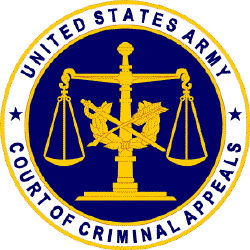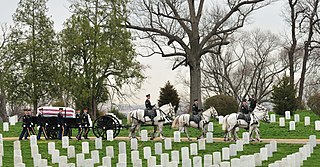The Uniform Code of Military Justice (UCMJ) is the foundation of the system of military justice of the armed forces of the United States. The UCMJ was established by the United States Congress in accordance with their constitutional authority, per Article I Section 8 of the U.S. Constitution, which provides that "The Congress shall have Power. .. to make Rules for the Government and Regulation of the land and naval forces" of the United States.
The National Defense Service Medal (NDSM) is a service award of the United States Armed Forces established by President Dwight D. Eisenhower in 1953. It was awarded to every member of the U.S. Armed Forces who served during any one of four specified periods of armed conflict or national emergency from June 27, 1950 through December 31, 2022. Combat or "in theater" service is not a requirement for the award.

The Individual Ready Reserve (IRR) is a category of the Ready Reserve of the Reserve Component of the Armed Forces of the United States composed of former active duty or reserve military personnel. Its governing statute is codified at 10 U.S.C. § 10144. For soldiers in the National Guard of the United States, its counterpart is the Inactive National Guard (ING). As of 22 June 2004, the IRR had approximately 112,000 members composed of enlisted personnel and officers, with more than 200 Military Occupational Specialties are represented, including combat arms, combat support, and combat service support.

The Good Conduct Medal is one of the oldest military awards of the United States Armed Forces. The U.S. Navy's variant of the Good Conduct Medal was established in 1869, the Marine Corps version in 1896, the Coast Guard version in 1923, the Army version in 1941, and the Air Force version in 1963; the Air Force Good Conduct Medal was temporarily discontinued from February 2006 to February 2009, followed by its subsequent reinstatement.

A Reserve Good Conduct Medal refers to any one of the five military conduct awards, four of which are currently issued and one of which was previously issued, by the United States Armed Forces to members of the Reserve and National Guard. The primary difference between the regular Good Conduct Medal and the Reserve Good Conduct Medal is that the regular Good Conduct Medal is only issued for active duty service while the reserve equivalent is bestowed for reserve duties such as drills, annual training, and additional active duty for either training or operational support to the active duty force or, in the case of the Army National Guard and Air National Guard, in support of Title 32 U.S.C. state active duty (SAD) such as disaster response and relief.

The Defense Commissary Agency (DeCA), headquartered at Fort Gregg-Adams, Virginia, is an agency of the United States Department of Defense (DoD) that operates nearly 240 commissaries worldwide. American military commissaries sell groceries and household goods to active-duty, Guard, Reserve, and retired members of all eight uniformed services of the United States and eligible members of their families at cost plus surcharge, saving authorized patrons thousands of dollars compared to civilian supermarkets.
In the US armed forces, separation means that a person is leaving active duty but not necessarily the service entirely. Separation typically occurs when someone reaches the date of their Expiration of Term of Service (ETS) and are released from active duty, but still must complete their military reserve obligations. Upon separation, they receive Form DD214, which verifies their military service.
An exchange is a type of retail store found on United States military installations worldwide. Originally akin to trading posts, they now resemble contemporary department stores or strip malls. Exact terminology varies by armed service; some examples include base exchange (BX), and post exchange (PX), and there are more specific terms for subtypes of exchange.

Courts-martial of the United States are trials conducted by the U.S. military or by state militaries. Most commonly, courts-martial are convened to try members of the U.S. military for violations of the Uniform Code of Military Justice (UCMJ). They can also be convened for other purposes, including military tribunals and the enforcement of martial law in an occupied territory. Federal courts-martial are governed by the rules of procedure and evidence laid out in the Manual for Courts-Martial, which contains the Rules for Courts-Martial (RCM), Military Rules of Evidence, and other guidance. State courts-martial are governed according to the laws of the state concerned. The American Bar Association has issued a Model State Code of Military Justice, which has influenced the relevant laws and procedures in some states.
The DD Form 214, Certificate of Release or Discharge from Active Duty, generally referred to as a "DD 214", is a document of the United States Department of Defense, issued upon a military service member's retirement, separation, or discharge from active duty in the Armed Forces of the United States.

In the United States military, the Army Court of Criminal Appeals (ACCA) is an appellate court that reviews certain court martial convictions of Army personnel.
A blue discharge, also called blue ticket, was a form of administrative military discharge formerly issued by the United States beginning in 1916. It was neither honorable nor dishonorable. The blue ticket became the discharge of choice for commanders seeking to remove homosexual service members from the ranks. They were also issued disproportionately to African Americans.
The United States military formerly excluded gay men, bisexuals, and lesbians from service. In 1993, the United States Congress passed, and President Bill Clinton signed, a law instituting the policy commonly referred to as "Don't ask, don't tell" (DADT), which allowed gay, lesbian, and bisexual people to serve as long as they did not reveal their sexual orientation. Although there were isolated instances in which service personnel were met with limited success through lawsuits, efforts to end the ban on openly gay, lesbian, and bisexual people serving either legislatively or through the courts initially proved unsuccessful.
In July 2008 the Post-9/11 GI Bill was signed into law, creating a new robust education benefits program rivaling the WWII Era GI Bill of Rights. The new Post 9/11 GI Bill, which went into effect on August 1, 2009, provides education benefits for service members who served on active duty for 90 or more days since September 10, 2001. These benefits are tiered based on the number of days served on active duty, creating a benefit package that gives current and previously activated National Guard and Reserve members the same benefits as active duty servicemembers.

The Veteran Health Identification Card (VHIC) is an identification card issued by the United States Department of Veterans Affairs (VA) for eligible veterans to receive medical care at VA Medical Facilities. The VHIC protects the privacy of veterans' sensitive information, as it no longer displays the Social Security number or date of birth on the front of the card. The VHIC will only display the veteran's name, picture, and special eligibility indicators—Service Connected, Purple Heart and former POW, if applicable, on the front of the card. Only veterans who are eligible for VA medical benefits will receive the card. Starting on Jan. 1, 2020, the Purple Heart and Disabled Veterans Equal Access Act allows Purple Heart recipients, former prisoners of war and veterans with service-connected disabilities entry onto military installations to use the AAFES Exchange; commissary and Morale, Welfare and Recreation facilities.
The Judge Advocate General's Corps, also known as JAG or JAG Corps, is the military justice branch or specialty of the United States Air Force, Army, Coast Guard, Marine Corps, and Navy. Officers serving in the JAG Corps are typically called judge advocates.

A military funeral in the United States is a memorial or burial rite conducted by the United States Armed Forces for a Soldier, Marine, Sailor, Airman, Guardian or Coast Guardsman who died in battle, a veteran, or other prominent military figures or a president. A military funeral may feature guards of honor, the firing of volley shots as a salute, drumming and other military elements, with a flag draping over the coffin.

In the past most lesbian, gay, bisexual, transgender, and queer (LGBTQ) personnel had major restrictions placed on them in terms of service in the United States military. As of 2010 sexual orientation and gender identity in the United States military varies greatly as the United States Armed Forces have become increasingly openly diverse in the regards of LGBTQ people and acceptance towards them.

The Veterans Identification Card (VIC) is an identification card issued by the US Department of Veterans Affairs (VA) to former military personnel as part of the Veterans Identification Card Act of 2015. The VIC allows veterans to demonstrate proof of service without the need for carrying their DD214, namely for discounts on goods and services offered by private individuals or organizations to veterans.

The Reserve Component of the Indonesian National Armed Forces is the military reserve force of Indonesia, jointly managed under the General Headquarters of the Indonesian National Armed Forces and the Indonesian Ministry of Defense.













